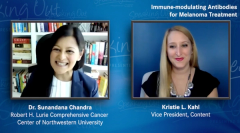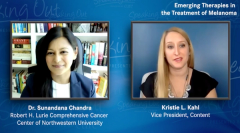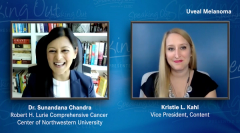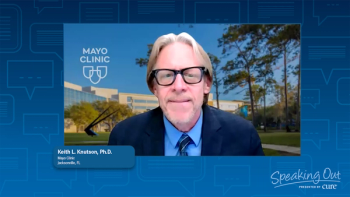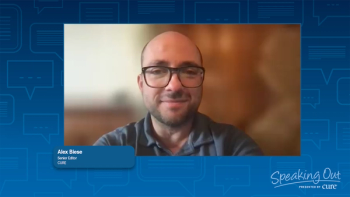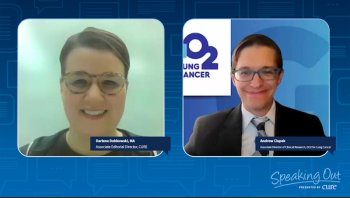
Adjuvant and Neoadjuvant Therapy in Melanoma
Updates in adjuvant and neoadjuvant therapy in melanoma
Episodes in this series
Kristie L. Kahl: What is the difference between adjuvant and neoadjuvant therapies?
Dr. Jeffrey Farma: Sure, it all has to do with when we give therapy and the point in time when we get therapy. So, when we talk about neoadjuvant therapy, that's where we're giving some sort of systemic therapy, or radiation before we actually are doing surgery. So it's become a really exciting area in the world of melanoma.
The consideration of neoadjuvant therapy, it wasn't something that we really ever did before, until the last, I would say, three to five years. And there's a lot of clinical trials that are ongoing looking at neoadjuvant therapy. And I'll kind of talk about a situation where I think it would be relevant. So a lot of times patients will come into our office for initial evaluation with melanoma, and they may have lymph nodes that we can feel that feel enlarged, they may have a larger melanoma, a primary melanoma in a place that we can feel or see. A lot of times, patients come in with a melanoma, and it's been biopsied, and we don't see anything except the scar.
But there is the subset of patients that come in that we would have somewhat advanced disease, and we may get a scan or a PET scan that doesn't show any evidence (the disease has) spread outside of a regional location like lymph nodes or the primary site of the melanoma. But when I see these patients, I think to myself, I'm concerned because in my head, they're high risk of having the melanoma come back. And in my mind, these are the first set of patients that I think are ideal for a consideration for a new approach, where before we jump to operating, we treat them with either immunotherapy initially, or if we test their specific genes in their tumor, specifically a BRAF mutation, we can give a BRAF/MEK inhibitors for a short period of time before surgery, in hopes of watching the tumor and shrinking it. And not only shrinking it, but potentially shrinking if there are cells that are around (the tumor) that we don't know about and our technology can't identify them.
And then we go to surgery to remove everything that we can see. And the reason why there's a lot of excitement about this is because in some of the earlier clinical trials that have been done, or where we've used this in select situations, we've seen really good responses. So, the tumors shrink, the lymph nodes shrink, or if it doesn't, it gives us a real time assessment that these medicines that we're using aren't working, and we should try the other ones if we can. And so there's a lot of excitement about a neoadjuvant approach.
And the second part of your question, adjuvant therapy, so that means after we do surgery. So, in patients who have the current standards or someone who has resection and either have their lymph nodes removed for palpable disease where they have enlarged or macroscopic lymph nodes, or if they underwent a resection and had a sentinel node biopsy that was positive. So melanoma cells had spread from the primary site to lymph nodes, then that's stage 3 disease and there's different levels of stage 3, but those patients would be if there's no evidence of spread elsewhere or metastatic disease would be candidates for adjuvant therapy. And really, we're using the same types of drugs, immunotherapy, which these medicines that use your immune system to fight cancer, or targeted therapy if you have a specific BRAF mutation to decrease the chance of the melanoma coming back.
And it was really exciting when these clinical trials first started. We really had no agents that really had any markable effect on melanoma, there was a couple that had a lot of toxicity. But it became really exciting when these medications came to the forefront and they were started in the metastatic setting and then there was clinical trials for stage 3 melanoma that showed improved survivals for both of these agents depending on the BRAF status, that if we give it for about a year after the surgery (there is) a decreased chance of melanoma coming back.
Kristie L. Kahl: Can you discuss what treatment sequencing is and how these play a role in doctors determining that treatment sequence?
Dr. Jeffrey Farma: It's really important to be seen by a team that specializes in melanoma. So we need, in our tumor board, on a weekly basis to discuss complicated cases like that. So we can have multiple experts from multiple disciplines discussing the case and coming up with multidisciplinary treatment plan personalized for that patient. And I think that's really important.
The sequencing, it really just depends sometimes we plan on resecting first and doing surgery first. And then we give adjuvant therapy. We currently have two neoadjuvant (therapy) trials now that are open at Fox Chase (Cancer Center). And it's still a clinical trial because we're still investigating this strategy.
We don't know definitive information that this is a better strategy. But we're gathering data and information from these clinical trials for the neoadjuvant strategy for treating melanoma. And I suspect in the future, and it's completely biased, but I think that this will be how we think and treat more patients with this approach. Because as I went back to this team, and when we had nothing, now we have these medications that are really amazing. We're seeing amazing responses. And so, if we can give a short course that improves outcomes, that's our goal, we want more patients to respond. And we want less patients to have their melanoma come back and we want patients to live longer and be cured of melanoma. And for advanced melanoma, we never said that before: curing melanoma. But it is a term that more commonly and thankfully we're using.
Kristie L. Kahl: Is there a particular patient population in the melanoma space that is in need of clinical trials to evaluate neoadjuvant and adjuvant therapy?
Dr. Jeffrey Farma: Yeah, that's a great question. So for the neoadjuvant approach, I think there's definitely these more advanced patients that present that don't have metastatic disease that I think are the ideal kind of patients that we consider. So as I said, I think the palpable nodes or a really bulky primary melanoma that someone that we could consider for the adjuvant (therapy). Currently, it's only for stage 3 melanoma. That being said, we know that there are stage 2 melanoma patients, and we break down the staging system to A, B or C, but to see specifically, we know is a high risk population, we know that the risk of melanoma coming back is very high of recurrence or having metastatic disease in some period of time. And so I think, ideally, we are going to see, and there's a couple of clinical trials out there looking at giving adjuvant therapy for stage 3 melanoma or even going to be, we're not doing that yet. But there is the potential of doing that in the future.
Kristie L. Kahl: Why is it important for these patients to consider joining a clinical trial?
Dr. Jeffrey Farma: A clinical trial helps us to answer questions in a systematic fashion. So you could say, well, give me those medicines, you're telling me they're so good, just give them to me, even if I have a stage 2 melanoma, why not get them? Well, the problem is that there are side effects there. And some of these side effects can be long standing, and we do a great job of controlling the side effects or correcting them. But some of them can be long standing side effects that … some patients may have to be on steroids for the rest of their life. So they're not completely, you know, without risks, these medications. And so it's always a risk-benefit profile, everything we do in medicine. So we want to make sure we're even if we're taking risk of side effects, that we're maximizing response rate or improving survival. But as you start kind of moving down to earlier, melanoma, well, then it may be that those patients aren't going to recur. So we have to kind of figure that out. And that's what clinical trials allow us to do, in really a rigorous fashion, to answer questions to make sure that we're really determining the best course of action for patients. Before we just say, oh, we're going to willy nilly give these medications to someone that could have long standing risks to them throughout their life.
Kristie L. Kahl: What do you think that we have to look forward to with adjuvant and neoadjuvant therapy in patients with melanoma?
Dr. Jeffrey Farma: So number one, I do think in the next few years, we'll start using neoadjuvant therapy outside of clinical trials, I think that the data will mature. And that we’ll start to utilize that outside of just clinical trials where it could be utilized in other practices, not just in the clinical trial environment. So I think that's a step forward. And so where patients instead of just jumping to surgery, where I love to operate, but I want to operate when I know it's helping someone, and where so sometimes where tumors shrink, we can potentially do less extensive surgery, so that means less risk of the operation potentially. And we also know that the medicines are working. So I think that's one thing in the short term that I suspect we will see more of in the next few years.
In the adjuvant setting, I'm really looking forward to these two kind of pathways that we have now are phenomenal but we always need to do better. We're looking at ways to decrease toxicity and increase response rate and increase cure rates. So there's many medications that are in the pipeline or combination therapies that will we'll be using. And also when I talked about the BRAF mutation that's very exciting, but they're melanomas. When we look at mutational status in patients with advanced melanoma, there is a lot of different mutations we identify. And the the key is going to be finding other targets that either, like the BRAF inhibitors if there's other inhibitors that we can identify. And this is why basic science and research are so important, to identify these new medications, that instead of just having four lines of therapy that we can consider for patients, because you know, only a small subset of patients have a BRAF mutation and are eligible for some of these drugs. But there's other mutations that we're seeing that are coming that we’ll have inhibitors for that will be exciting that we can also use in both the adjuvantand or potentially neoadjuvant.
I think all of these, it starts in the metastatic setting and then adjuvant and then we move into the neoadjuvant approach. And the neoadjuvant approach is not new. So I treat other cancers besides melanoma, but there's a big push and change in how we think about cancer and using this new address and approach for a lot of types of cancers (stomach cancer, pancreas, rectal cancer), where we treat first and has shown in a lot of different series to decrease the rates of it coming back locally, and or even metastatic disease. So this is not a new concept just for melanoma, but we are using it in different types of cancers and all different types of cancers really.

